|
|
|
|
|
Oil On
Canvas, Real Flavor of Old Masters
|
|

|
ARTWORKS
INDEX
A B C D E F G H I J K L M N O P Q R S T U V W X Y Z |
ARTISTS
INDEX
A B C D E F G H I J K L M N O P Q R S T U V W X Y Z |
|
|
| | |
|
|
 |
GUERCINO -- Click Here
|
|
Italian Baroque Era Painter, 1591-1666
best known as Guercino or Il Guercino, was an Italian Baroque painter from the region of Emilia, and active in Rome and Bologna. Guercino is Italian for squinter, a nickname that was given to him because he was cross-eyed. He is especially noted for his many superb drawings. Guercino was born at Cento, a village between Bologna and Ferrara. By the age of 17 he was associated with Benedetto Gennari, a painter of the Bolognese School. By 1615 he moved to Bologna, where his work earned the praise of an elder Ludovico Carracci. He painted two large canvases, Elijah Fed by Ravens and Samson Seized by Philistines, in what appears to be a stark naturalist Caravaggesque style (although it is unlikely he had been able to see any of the Roman Caravaggios first-hand). They were painted for Cardinal Serra, Papal Legate to Ferrara. The Arcadian Shepherds (Et in Arcadia ego) was painted in 1618 contemporary with The Flaying of Marsyas by Apollo in Palazzo Pitti. His first style, he often claimed, was influenced by a canvas of Carracci in Cento. Some of his later pieces approach rather to the manner of his great contemporary Guido Reni, and are painted with more lightness and clearness. Guercino was esteemed very highly in his lifetime. He was then recommended by Marchese Enzo Bentivoglio to the Bolognese Ludovisi Pope, Pope Gregory XV. His two years (1621-23) spent in Rome were very productive. From this stay date his frescoes of Aurora at the casino of the Villa Ludovisi and the ceiling in San Crisogono (1622) of San Chrysogonus in Glory; his portrait of Pope Gregory (now in the Getty Museum, and, what is considered his masterpiece, The Burial of Saint Petronilla or St. Petronilla Altarpiece, for the Vatican (now in the Museo Capitolini). The Franciscan order of Reggio in 1655 paid him 300 ducats for the altarpiece of Saint Luke Displaying a Painting of the Madonna and Child (now in Nelson-Atkins Museum of Art, Kansas City). The Corsini also paid him 300 ducats for the Flagellation of Christ painted in 1657. |
|
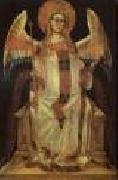 |
GUARIENTO d Arpo -- Click Here
|
|
Italian painter (active 1338-1368 in Padua) |
|
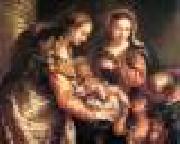 |
GUARDI, Gianantonio -- Click Here
|
|
Italian Rococo Era Painter, ca.1699-1761
|
|
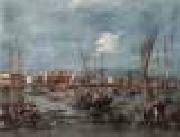 |
GUARDI, Francesco -- Click Here
|
|
Italian Rococo Era Painter, 1712-ca.1793
The records of his parish in Venice show that Francesco Guardi was baptized on Oct. 5, 1712. His father, Domenico, who died when Francesco was 4, had a workshop. Francesco and his elder brother, Gian Antonio, worked in a small studio, carrying out such orders as they could get for almost anything the client wanted:mythological pictures, genre, flower pieces, battle scenes, altarpieces, and even, on rare occasions, frescoes. They did not hesitate to copy compositions by other artists, but what they borrowed they always transformed into something more capricious, less stable, more fragmentary in the refraction of light. Francesco did not emerge as an independent personality until 1760, when his brother died. Then, 48 years old, he married, established his own studio, and devoted himself chiefly to painting views of Venice. For the most part he worked in obscurity, ignored by his contemporaries. He was not even admitted to the Venetian Academy until he was 72 years old. Guardi and Canaletto have always been compared to one another because the buildings they chose to paint were often the same. But the way each artist painted them is very different. Canaletto's world is constructed out of line. It provides solid, carefully drawn, three-dimensional objects that exist within logically constructed three-dimensional space. Guardi's world is constructed out of color and light. The objects in it become weightless in the light's shimmer and dissolve in a welter of brushstrokes; the space, like the forms in space, is suggested rather than described. Canaletto belonged essentially to the Renaissance tradition that began with Giotto and, as it grew progressively tighter and more controlled, pointed the way to neoclassicism. Guardi belonged to the new baroque tradition that grew out of the late style of Titian and, as it became progressively looser and freer, pointed the way toward impressionism. Such differences appear even in Guardi's early view paintings, where he was obviously trying to copy Canaletto, such as the Basin of San Marco. The famous buildings are there, but they are far in the background, insubstantial, seeming to float. In front is a fleet of fishing boats, their curving spars seeming to dance across the surface of the canvas. What is important for Guardi is not perspective but the changing clouds and the way the light falls on the lagoon. Guardi became increasingly fascinated by the water that surrounds Venice. In late works, such as the famous Lagoon with Gondola, buildings and people have been stripped away until there is nothing but the suggestion of a thin line of distant wharfs, a few strokes to indicate one man on a gondola, a long unbroken stretch of still water, and a cloudless sky. Guardi also painted the festivals that so delighted visitors to the city, such as the Marriage of Venice to the Sea. This was a symbolic ceremony in which the doge, in the great gilded galley of the head of state, surrounded by a thousand gondolas, appeared before all Venice, in Goethe's image, "raised up like the Host in a monstrance." Of all Guardi's paintings the most evocative are his caprices, the landscapes born out of his imagination though suggested by the ruined buildings on the lonely islands of the Venetian lagoon. A gentle melancholy clings to such scenes.
|
|
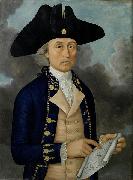 |
Guan Zuolin of Macao -- Click Here
|
|
painted Portrait of Captain Joseph Huddart in c. 1785 |
|
 |
Grunewald, Matthias -- Click Here
|
|
German Northern Renaissance Painter, ca.1470-1528
.the traditional name of a painter whose real name is believed to have been Nithardt or Neithardt. He was active at Isenheim nr. Colmar c.1514 and in Frankfurt c.1526. Gr??newald's principal work, an elaborate altarpiece of many panels painted for the monastery at Isenheim (Isenheimer Altar), is now in the Colmar museum. |
|
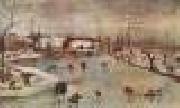 |
GRIMMER, Jacob -- Click Here
|
|
Flemish Baroque Era Painter, ca.1570-C.1619 |
|
 |
GRIMMER, Abel -- Click Here
|
|
Flemish Baroque Era Painter, ca.1570-C.1619
Son of Jacob Grimmer. He married Catharina Lescornet on 29 September 1591 and in 1592 became a master in the Antwerp Guild of St Luke. He is principally known for his numerous small paintings of country scenes, sometimes with a biblical theme, which often form part of a series of the Four Seasons or the Months of the Year. Some of these paintings were inspired by or even copied from prints by Pieter Bruegel I and Hans Bol, both of whose work strongly influenced Abel, even more so than did the example of his father's work, which was also an important source of inspiration. Abel's series of the Twelve Months (1592; Montfaucon-en-Velay, Haute-Loire, Chapelle Notre-Dame) are exact copies of Adriaen Collaert's prints after Hans Bol (Hollstein: Dut. & Flem., iv, nos 523-34), published by Hans van Luyck ( fl c. 1580-85) in 1585. Spring and Summer (Antwerp, Kon. Mus. S. Kst.) are almost exact copies of two prints by Pieter van der Heyden |
|
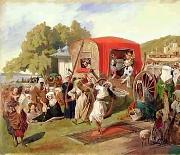 |
Grigory Gagarin -- Click Here
|
|
Russian: 11 May [O.S. 29 April] 1811 - 30 January [O.S. 18 January] 1893) was a Russian painter, Major General and administrator.
Grigory Gagarin was born in Saint Petersburg to the noble Rurikid princely Gagarin family. His father, Prince Grigory Ivanovich Gagarin (Saint Petersburg, 17 March 1782 - Tegernsee, 12 February 1837), was a Russian diplomat in France and later the ambassador to Italy. His father married in Saint Petersburg in 1809 his mother Yekaterina Petrovna Sojmonova (Saint Petersburg, 23 May 1790 - Moscow, 27 February 1873). Thus until the age 13 the boy was with his family in Paris and Rome and then studied in the collegium Tolomei in Siena. Grigory did not receive a formal artistic education, but took private lessons from the famous Russian painter Karl Briullov who at that time lived in Italy.
In 1832 he returned to Saint Petersburg, became acquainted with Alexander Pushkin and illustrated his works The Queen of Spades and The Tale of Tsar Saltan.He also became close to the opposition Circle of Sixteen and Mikhail Lermontov. |
|
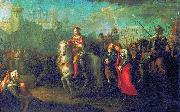 |
Grigoriy Ugryumov -- Click Here
|
|
painted Alexander Nevsky in Pskov, after they victory over the Germans in 1793. |
|
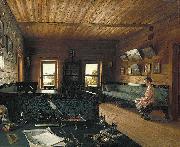 |
Grigoriy Soroka -- Click Here
|
|
(Russian, real surname Vasilyev. November 27 [O.S. November 15] 1823-April 22 [O.S. April 10] 1864) was a Russian painter, one of the most notable members of Venetsianov school.
Soroka was born in Pokrovskoye village (Tver Guberniya), in the family of landowner Milyukov. In 1842-1847 he studied art from Alexey Venetsianov then he was returned to his owner. In 1850s-1860s he resided in his home village. He fell in love with his owners's daughter Lydia but was forcibly married to a serf woman. After the emancipation reform of 1861 in Russia, Soroka remained under the serfdom system. He made a formal complaint but it was rejected and he was flogged. Soroka's body was found in the baking room where he had hanged himself. His beloved Lydia poisoned herself soon after. |
|
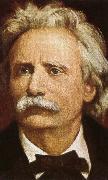 |
grieg -- Click Here
|
|
Period: Post-Romantic (1870-1909)
Country: Norway
Born: June 15, 1843 in Bergen, Norway
Died: September 04, 1907 in Bergen, Norway
Genres: Chamber Music, Concerto, Keyboard Music, Miscellaneous Music, Orchestral Music, Vocal Music |
|
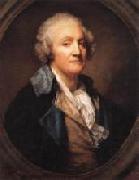 |
GREUZE, Jean-Baptiste -- Click Here
|
|
French Rococo Era Painter, 1725-1805
French painter and draughtsman. He was named an associate member of the Academie Royale de Peinture et de Sculpture, Paris, in 1755 on the strength of a group of paintings that included genre scenes, portraits and studies of expressive heads . These remained the essential subjects of his art for the next 50 years, except for a brief, concentrated and unsuccessful experiment with history painting in the late 1760s, which was to affect his later genre painting deeply. Though his art has often been compared with that of Jean-Simeon Chardin in particular and interpreted within the context of NEO-CLASSICISM in general, it stands so strikingly apart from the currents of its time that Greuze's accomplishments are best described, as they often were by the artist's contemporaries, as unique. He was greatly admired by connoisseurs, critics and the general public throughout most of his life. His pictures were in the collections of such noted connoisseurs as Ange-Laurent de La Live de Jully, Claude-Henri Watelet and Etienne-Francois, Duc de Choiseul. For a long period he was in particular favour with the critic Denis Diderot, who wrote about him in the Salon reviews that he published in Melchior Grimm's privately circulated Correspondance litt?raire. His reputation declined towards the end of his life and through the early part of the 19th century, to be revived after 1850, when 18th-century painting returned to favour, by such critics as Theophile Thore, Ars?ne Houssaye and, most notably, Edmond and Jules de Goncourt in their book L'Art du dix-huitieme siecle. By the end of the century Greuze's work, especially his many variations on the Head of a Girl, fetched record prices, and his Broken Pitcher (Paris, Louvre) was one of the most popular paintings in the Louvre. The advent of modernism in the early decades of the 20th century totally obliterated Greuze's reputation. |
|
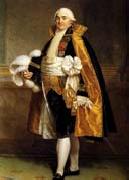 |
GREGORIUS, Albert -- Click Here
|
|
Belgian painter
b. 1774, Bruges, d. 1853, Bruges |
|
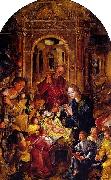 |
Gregorio Lopes -- Click Here
|
|
Gregorio Lopes (c. 1490 - 1550) was one of the most important Renaissance painters from Portugal.
Gregorio Lopes was educated in the workshop of Jorge Afonso, the court painter of King Manuel I. Later he himself became court painter for both Manuel I and for his successor, John III. In 1514 he married the daughter of Jorge Afonso, and in 1520 was knighted by Prince Jorge de Lencastre and entered the Order of Santiago.
The work of Gregorio Lopes mainly consists of painted religious altarpieces for various churches and monasteries in central Portugal. Between 1520 and 1525 he worked (together with Jorge Leal) in painting altarpieces for the Saint Francis Convent of Lisbon. Also in the 1520s he painted panels for the Church of Paraeso (Paradise), also in Lisbon. In his first fase, Gregorio Lopes also worked in Sesimbra, Setebal and in the Monastery of Ferreirim, in this latter case together with Cristevao de Figueiredo and Garcia Fernandes.
The painter moved in the 1530s to the city of Tomar, where he painted various panels for the Round Church of the Convent of Christ (1536 - 1539) and the main altarpiece of the Church of Saint John the Baptist (1538 - 1539). His last known works include altarpieces for the Convent of Santos-o-Novo in Lisbon (1540) and the Valverde Convent, near Évora (1545). |
|
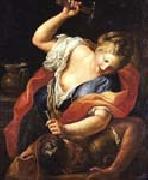 |
Gregorio Lazzarini -- Click Here
|
|
(1657 - 10 November 1730) was an Italian painter, mostly of religious subjects, and those from history and mythology.
Born in Venice, he initially trained with the Genovese painter Francesco Rosa, Girolamo Forabosco, and with the studio of Pietro della Vecchia. He joined the painters' guild in Venice in 1687. |
|
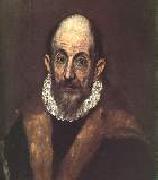 |
GRECO, El -- Click Here
|
|
Greek-born Spanish Mannerist Painter, 1541-1614
Greek painter, designer and engraver, active in Italy and Spain. One of the most original and interesting painters of 16th-century Europe, he transformed the Byzantine style of his early paintings into another, wholly Western manner. He was active in his native Crete, in Venice and Rome, and, during the second half of his life, in Toledo. He was renowned in his lifetime for his originality and extravagance and provides one of the most curious examples of the oscillations of taste in the evaluation of a painter,
|
|
 |
Greco El -- Click Here
|
|
Spanish painter of Greek origin (b. 1541, Candia, d. 1614, Toledo). Paintings in Crete (until 1567) Paintings in Venice (1567-70) Paintings in Rome (1570-75) First commissions in Spain (1576-80) , He was a painter, sculptor, and architect of the Spanish Renaissance. "El Greco" (The Greek) was a nickname,a reference to his Greek origin, and the artist normally signed his paintings with his full birth name in Greek letters, (Domenikos Theotokopoulos). El Greco was born in Crete, which was at that time part of the Republic of Venice, and the centre of Post-Byzantine art. He trained and became a master within that tradition before travelling at age 26 to Venice, as other Greek artists had done. In 1570 he moved to Rome, where he opened a workshop and executed a series of works. During his stay in Italy, El Greco enriched his style with elements of Mannerism and of the Venetian Renaissance. In 1577 he moved to Toledo, Spain, where he lived and worked until his death. In Toledo, El Greco received several major commissions and produced his best known paintings. El Greco's dramatic and expressionistic style was met with puzzlement by his contemporaries but found appreciation in the 20th century. |
|
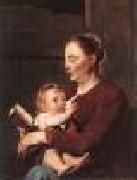 |
GREBBER, Pieter de -- Click Here
|
|
Dutch painter, Haarlem school (b. ca. 1600, Haarlem, d. 1652/53, Haarlem)Dutch painter. Together with Salomon de Bray, he was a pioneer among the Haarlem Classicists |
|
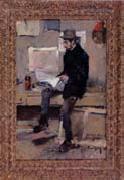 |
Graph paul -- Click Here
|
|
Stockolm,1866
Enkoting 1903
|
|
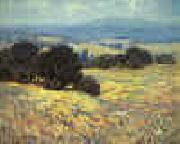 |
Granville Redmond -- Click Here
|
|
1871-1935
Granville attended the Berkeley School for the Deaf (later the California School for the Deaf) from 1879 to 1890 where his artistic talents were recognized and encouraged. There his teacher Theophilus d'Estrella taught him painting, drawing and pantomime.
When he graduated from CSD, Redmond enrolled at another CSD: the California School of Design in San Francisco, where he worked for three years with teachers such as Arthur Matthews and Amedee Joullion. He famously won the W. E. Brown Medal of Excellence. He associated with many other artists, including Gottardo Piazzoni and Giuseppe Cadenasso. Piazzoni learned American Sign Language and he and Redmond were lifelong friends. They lived together in Parkfield, California, and Tiburon.
1893 saw Redmond win a scholarship from California School of the Deaf and from the School of Design, which made it possible for him to study in Paris at the Academie Julian under teachers Jean-Paul Laurens and Benjamin Constant. At the Academie Julian, he roomed with sculptor Douglas Tilden, famous deaf sculptor and another graduate of the California School for the Deaf. In 1895 in Paris his painting Matin d'Hiver, was accepted for the Paris Salon. |
|
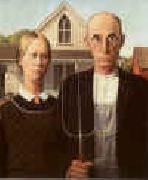 |
Grant Wood -- Click Here
|
|
1891-1942
Grant Wood Locations
His family moved to Cedar Rapids after his father died in 1901. Soon thereafter he began as an apprentice in a local metal shop. After graduating from Washington High School (Cedar Rapids, Iowa) , Wood enrolled in an art school in Minneapolis in 1910, and returned a year later to teach in a one-room schoolhouse. In 1913 he enrolled at the School of the Art Institute of Chicago and did some work as a silversmith.
From 1920 to 1928 he made four trips to Europe, where he studied many styles of painting, especially impressionism and post-impressionism. But it was the work of Jan Van Eyck that influenced him to take on the clarity of this new technique and to incorporate it in his new works. From 1924 to 1935 Wood lived in the loft of a carriage house that he turned into his personal studio at "5 Turner Alley" (the studio had no address until Wood made one up himself). In 1932, Wood helped found the Stone City Art Colony near his hometown to help artists get through the Great Depression. He became a great proponent of regionalism in the arts, lecturing throughout the country on the topic.
Wood taught painting at the University of Iowa's School of Art beginning in 1934. During that time, he supervised mural painting projects, mentored students, produced a variety of his own works, and became a key part of the University's cultural community. On February 12, 1942, one day before his 51st birthday, Wood died at the university hospital of liver cancer.
When Wood died, his estate went to his sister, Nan Wood Graham, the woman portrayed in American Gothic. When she died in 1990, her estate, along with Wood's personal effects and various works of art, became the property of the Figge Art Museum in Davenport, Iowa.
Wood was an active painter from an extremely young age until his death, and although he is best known for his paintings, he worked in a large number of media, including ink, charcoal, ceramics, metal, wood and found objects.
Throughout his life he hired out his talents to many Iowa-based businesses as a steady source of income. This included painting advertisements, sketching rooms of a mortuary house for promotional flyers and, in one case, designing the corn-themed decor (including chandelier) for the dining room of a hotel. In addition, his 1928 trip to Munich was to oversee the making of the stained-glass windows he had designed for a Veterans Memorial Building in Cedar Rapids. He again returned to Cedar Rapids to teach Junior High students after serving in the army as a camouflage painter. |
|
 |
granados -- Click Here
|
|
Period: Post-Romantic (1870-1909)
Country: Spain
Born: July 27, 1867 in L??rida, Spain
Died: March 24, 1916 in At sea (in the English Channel)
Genres: Chamber Music, Keyboard Music, Miscellaneous Music, Opera, Vocal Music
|
|
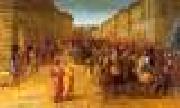 |
GRANACCI, Francesco -- Click Here
|
|
Italian High Renaissance Painter, ca.1469-1543
was an Italian painter of the Renaissance. Born at Villamagna di Volterra, he trained in Florence in the studio of Domenico Ghirlandaio, and was employed painting frescoes for San Marco on commission of Lorenzo de'Medici. He is featured in Giorgio Vasari's Vite. His early works, such as the Enthroned Madonna between Saint Michael and John the Baptist (Staatliche Museen, Berlin), Adoration of the Child (Honolulu Academy of Arts) and four histories of Saint John the Baptist, were influenced by the style of Filippino Lippi. In 1508, Granacci went to Rome, where he and other artists helped his lifelong friend Michelangelo to transfer cartoons to the Sistine chapel ceiling. Returning to Florence, Granacci painted a Madonna with Child with Saints Francesco and Jerome for the Augustinian convent of San Gallo (now in the Gallery of the Academy), a Madonna della Cintola for the Company of San Benedetto Bigi, and in 1515 he participated in creating the decorations to celebrate the visit to Florence of Pope Leo X. In 1519, he painted a Madonna with Child and Saint John. Works of the years 1520-1525 betray a direct influence of Fra Bartolomeo, including a Madonna in throne between Saints Sebastiano and Francesco for Castelfiorentino and a Sacred Conversation for Montemurlo. An altarpiece of the Assumption is influenced by Pietro Perugino. |
|
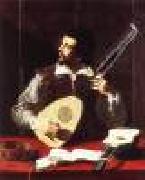 |
GRAMATICA, Antiveduto -- Click Here
|
|
Italian Baroque Era Painter, 1571-1626
Italian painter. He was from a Sienese family. According to Baglione, his parents were journeying from Siena to Rome when his mother went into labour and gave birth to him at an inn, an inconvenience that had been foreseen ('antiveduto') by his father and led to his unusual name. For a brief period he was a pupil of Giandomenico Angelini ( fl 1550-1600), under whom he painted small-scale works, mainly on copper. His prolific production of devotional paintings, portraits and copies of portraits won him swift success; in 1593 he became a member of the Accademia di S Luca and in 1604 of the Congregazione dei Virtuosi. His early portraits have not been identified; they included highly popular copies of a series of Famous Men then at the Villa Medici, works that Caravaggio probably also copied when he worked for some months in his studio on his arrival in Rome in 1592 |
|
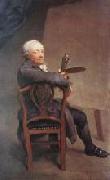 |
GRAFF, Anton -- Click Here
|
|
Swiss-born German Painter, 1736-1813
Swiss painter, active in Germany. He was a pupil of Johann Ulrich Schellenburg (1709-95) in Winterthur and continued his training with Johann Jakob Haid in Augsburg between 1756 and 1765. He worked for the court painter Leonhard Schneider (1716-62) in Ansbach from 1757 to 1759, producing large numbers of copies of a portrait of Frederick the Great (probably by Antoine Pesne). This was an important step in furthering his career, as were the months he spent in Regensburg (1764-5) painting miniatures of clerics and town councillors. He was court painter to the Elector Frederick-Christian of Saxe-Weimar in Dresden from 1766 and taught at the Hochschule der Bildende Kenste there. In 1771 he travelled to Berlin, where he painted portraits of Jakob Mendelssohn, Gotthold Ephraim Lessing and J. G. Sulzer. Sulzer introduced him at court, which resulted in many commissions. He was invited several times to teach at the Akademie der Kenste in Berlin, but he remained in Dresden. He often travelled to Leipzig, and in summer he frequently went to Teplitz |
|
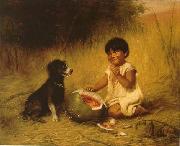 |
Grace Hudson -- Click Here
|
|
(1865 - 1937) was an American painter. She was nationally known during her lifetime for a numbered series of more than 684 portraits of the local Pomo Indians. She painted the first, "National Thorn", after her marriage in 1891, and the last in 1935.
Grace Carpenter was born in Potter Valley, California. Her mother was one of the first white school teachers educating Pomo children and was a commercial portrait photographer in Ukiah, California; her father was a skilled panoramic and landscape photographer who chronicled early Mendocino County frontier enterprises such as logging, shipping and railroading. At fourteen years of age, Grace was sent to attend the recently-established San Francisco School of Design, an art school which emphasized painting from nature rather than from memory or by copying existing works. At sixteen, she executed an award-winning, full length, life sized self-portrait in crayon. While in San Francisco, she met and eloped with a man fifteen years her senior named William Davis, upsetting her parents and ending her formal studies. The marriage lasted only a year.
From 1885 to 1890, Grace Carpenter Davis lived with her parents in Ukiah painting, teaching and rendering illustrations for magazines such as Cosmopolitan and Overland Monthly. Her work at that time had no particular focus and included genre, landscapes, portraits and still lifes in all media. Later in her career she would continue to accept occasional magazine illustration assignments including ones for Sunset.
|
|
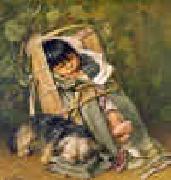 |
Grace Carpenter Hudson -- Click Here
|
|
1865-1937
Grace Carpenter Hudson Galleries
Grace Carpenter Hudson (1865 - 1937) was an American painter. She was nationally known during her lifetime for a numbered series of more than 684 portraits of the local Pomo Indians. She painted the first, "National Thorn", after her marriage in 1891, and the last in 1935.
Grace Carpenter was born in Potter Valley, California. Her mother was one of the first white school teachers educating Pomo children and was a commercial portrait photographer in Ukiah, California; her father was a skilled panoramic and landscape photographer who chronicled early Mendocino County frontier enterprises such as logging, shipping and railroading.[1] At fourteen years of age, Grace was sent to attend the recently-established San Francisco School of Design, an art school which emphasized painting from nature rather than from memory or by copying existing works. At sixteen, she executed an award-winning, full length, life sized self-portrait in crayon. While in San Francisco, she met and eloped with a man fifteen years her senior named William Davis, upsetting her parents and ending her formal studies. The marriage lasted only a year.
From 1885 to 1890, Grace Carpenter Davis lived with her parents in Ukiah painting, teaching and rendering illustrations for magazines such as Cosmopolitan and Overland Monthly. Her work at that time had no particular focus and included genre, landscapes, portraits and still lifes in all media. Later in her career she would continue to accept occasional magazine illustration assignments including ones for Sunset. |
|
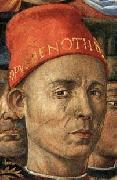 |
GOZZOLI, Benozzo -- Click Here
|
|
Italian Early Renaissance Painter, 1420-1497
Italian Renaissance painter. Early in his career he assisted Lorenzo Ghiberti on the east doors of the Baptistery in Florence and Fra Angelico on frescoes in Florence, Rome, and Orvieto. His reputation today rests on the breathtaking fresco cycle The Journey of the Magi (1459 C 61) in the chapel of Florence's Medici-Riccardi Palace. His work as a whole was undistinguished, however. He painted several altarpieces and a series of 25 frescoes of Old Testament scenes
|
|
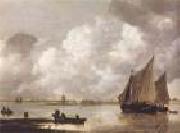 |
GOYEN, Jan van -- Click Here
|
|
Dutch Baroque Era Painter, 1596-1656
Jan van Goyen was born in Leiden on Jan. 13, 1596. Apprenticed from the age of 10, he had several masters. About 1617 he went to Haarlem to study with Esaias van de Velde, an important innovator in the Haarlem movement of realistic landscape painting. Van Goyen's works between 1621 and 1625 are sometimes hard to distinguish from those of his teacher. They are colorful, detailed views of villages and roads, usually busy with people, as in Winter (1621). It was Van Goyen's usual practice to sign or monogram and date his paintings. He traveled extensively through the Netherlands and beyond, recording his impressions in sketchbooks, occasionally with dates and often depicting recognizable scenes. Thus the chronology of his development is clear. His paintings of the late 1620s show a steady advance from the strong colors and scattered organization of his early works toward tonality and greater simplicity and unity of composition. By 1630 he was painting monochromes in golden brown or pale green; he played a leading part in the tonal phase of Dutch landscape painting. In 1631 Van Goyen settled in The Hague, where he became a citizen in 1634. The simplicity, airiness, and unification of his compositions continued to increase in his abundant production of dune landscapes, river views, seascapes, town views, and winter landscapes. The River View (1636) displays a river so open and extensive as to suggest the sea, with reflections that prolong the vast and luminous sky. In its monumentalization of humble structures and its composition built on a firm scaffolding of horizontal and vertical forces, it forecast at this early date developments that dominated landscape painting in the 1650s and later. In the Village and Dunes (1647) the traditional double-diagonal composition still exists, but it is dominated by horizontal and vertical accents. Stronger contrasts of light and dark replace the earlier tonality. In the last year of his life Van Goyen produced an eloquent new style, in which powerful forms stand out against the radiant sky and water in an exquisitely balanced composition (Evening Calm; 1656). The commission in 1651 to paint a panoramic view of The Hague for the Burgomaster's Room shows the high regard in which Van Goyen was held. He was enormously productive; well over 1,000 of his paintings still exist, and almost as many drawings. Yet he died insolvent, perhaps because of losses in his various business ventures, and soon after his death on April 27, 1656, |
|
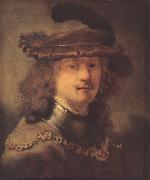 |
Govert flinck -- Click Here
|
|
Dutch Baroque Era Painter, 1615-1660
was a Dutch painter of the Dutch Golden Age. Born at Cleves, he was apprenticed by his father to a silk mercer, but having secretly acquired a passion for drawing, was sent to Leeuwarden, where he boarded in the house of Lambert Jacobszon, a Mennonite, better known as an itinerant preacher than as a painter. Here Flinck was joined by Jacob Backer, and the companionship of a youth determined like himself to be an artist only confirmed his passion for painting. Amongst the neighbours of Jacobszon at Leeuwarden were the sons and relations of Rombertus van Uylenburgh, whose daughter Saske married Rembrandt in 1634. Other members of the same family lived at Amsterdam, cultivating the arts either professionally or as amateurs. The pupils of Lambert probably gained some knowledge of Rembrandt by intercourse with the Ulenburgs. Certainly Joachim von Sandrart, who visited Holland in 1637, found Flinck acknowledged as one of Rembrandt's best pupils, and living habitually in the house of the dealer Hendrik Uylenburg at Amsterdam. For many years Flinck laboured on the lines of Rembrandt, following that master's style in all the works which he executed between 1636 and 1648. With aspirations as a history painter, however, he looked to the swelling forms and grand action of Peter Paul Rubens, which led to many commissions for official and diplomatic painting. Flinck's relations with Cleves became in time very important. He was introduced to the court of the Great Elector, Friedrich Wilhelm I of Brandenburg, who married in 1646 Louisa of Orange. He obtained the patronage of John Maurice of Nassau, who was made stadtholder of Cleves in 1649. In 1652 a citizen of Amsterdam, Flinck married in 1656 an heiress, daughter of Ver Hoeven, a director of the Dutch East India Company. |
|
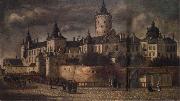 |
Govert Dircksz Camphuysen -- Click Here
|
|
Dutch Baroque Era Painter, ca.1623-1672 |
|
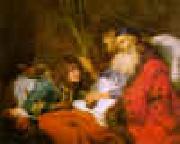 |
Govaert Flinck -- Click Here
|
|
1615-1660
Dutch
Govaert Flinck Locations
Born at Cleves, he was apprenticed by his father to a silk mercer, but having secretly acquired a passion for drawing, was sent to Leeuwarden, where he boarded in the house of Lambert Jacobszon, a Mennonite, better known as an itinerant preacher than as a painter.
Here Flinck was joined by Jacob Backer, and the companionship of a youth determined like himself to be an artist only confirmed his passion for painting. Amongst the neighbours of Jacobszon at Leeuwarden were the sons and relations of Rombertus van Uylenburgh, whose daughter Saske married Rembrandt in 1634. Other members of the same family lived at Amsterdam, cultivating the arts either professionally or as amateurs. The pupils of Lambert probably gained some knowledge of Rembrandt by intercourse with the Ulenburgs. Certainly Joachim von Sandrart, who visited Holland in 1637, found Flinck acknowledged as one of Rembrandt best pupils, and living habitually in the house of the dealer Hendrik Uylenburg at Amsterdam.
For many years Flinck laboured on the lines of Rembrandt, following that master style in all the works which he executed between 1636 and 1648. With aspirations as a history painter, however, he looked to the swelling forms and grand action of Peter Paul Rubens, which led to many commissions for official and diplomatic painting. Flinck relations with Cleves became in time very important. He was introduced to the court of the Great Elector, Friedrich Wilhelm I of Brandenburg, who married in 1646 Louisa of Orange. He obtained the patronage of John Maurice of Nassau, who was made stadtholder of Cleves in 1649. In 1652 a citizen of Amsterdam, Flinck married in 1656 an heiress, daughter of Ver Hoeven, a director of the Dutch East India Company. He was already well-known even then in the patrician circles over which the burgomasters De Graef and the Echevin Six presided; he was on terms of intimacy with the poet Vondel and the treasurer Uitenbogaard. In his house, adorned with antique casts, costumes, and a noble collection of prints, he often received the stadtholder John Maurice, whose portrait is still preserved in the work of the learned Barleius. |
|
|
|
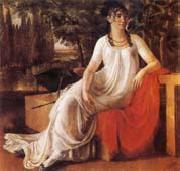 |
Gottlieb Schick -- Click Here
|
|
romanticism artist. German, 1776-1812
German painter. He trained at the H?he Karlsschule in Stuttgart (1795-7) under the classically-orientated painter Philipp Friedrich von Hetsch (1758-1839), a pupil of David. Schick also took private lessons (1797-8) with the sculptor Johann Heinrich von Dannecker. From 1799 to 1802 Schick studied in Paris under David, and he soon became one of David's favourite students. He made two unsuccessful attempts to win the Prix de Rome with compositions that derived from the style of David. However, greater independence is seen in his life-size painting Eve (1800; Cologne, Wallraf-Richartz-Mus.), a magnificent allegory of Beauty synthesizing a classically-orientated reinterpretation of ancient art and a proto-Romantic interpretation of biblical subject-matter, inspired by Milton's Paradise Lost. As Schick himself stated (letter to Dannecker, 10 July 1800), he had tried to emulate both the Medici Venus and the female figures of Raphael. In 1802, on a pension from Frederick II, Duke of Werttemburg, Schick moved to Rome and for almost a decade played a leading role in Roman artistic life. His friendship with Joseph Anton Koch led to mutual influence in the work of the two artists. Koch was indebted to Schick for invaluable hints on oil painting and for choice of subjects. For a fortnight in July 1805, Schick exhibited in the Pantheon his large oil painting The Sacrifice of Noah (2.50*3.27 m, 1804; Stuttgart, Staatsgal.). The work was inspired by Raphael's Old Testament frescoes in the Vatican Loggie; and it brought Schick enormous success. Despite financial hardship, Schick continued to work indefatigably, and without waiting for commissions, on a wide variety of projects. These included biblical and mythological subjects as well as portraits. Between 1806 and 1808 he completed his Apollo among the Shepherds (Stuttgart, Staatsgal.), a subject he had attempted while still in Paris and then again in Rome in 1805. The second Rome version had clearly gained through Schick's concentrated thought over a period of several years, and the result represented an avowal of faith both in the artist's own gifts and in German Classicism. |
|
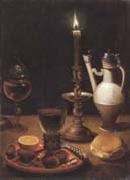 |
Gotthardt de Wedig -- Click Here
|
|
German, 1583-1641 |
|
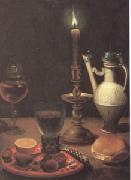 |
Gottfried Von Wedig -- Click Here
|
|
Cologne 1583-1641 |
|
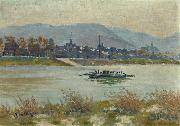 |
Gottfried Trimborn -- Click Here
|
|
painted Rheinfahre in 1920 |
|
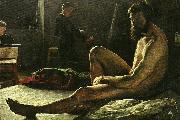 |
gottfrid kallstenius -- Click Here
|
|
seated male model, 1887-88.
royal academy of fine arts |
|
_a.jpg) |
GOSSAERT, Jan (Mabuse) -- Click Here
|
|
Flemish Northern Renaissance Painter, ca.1478-1532
|
|
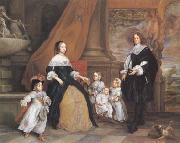 |
Gonzales Coques -- Click Here
|
|
1615 - 1684
was a Flemish Baroque painter He was the son of Pieter Willemsen Coques, a respectable Flemish citizen, and not, as his name might imply, a Spaniard, was born in Antwerp. In 1626?C28 he entered the studio of Pieter Brueghel the Younger, and subsequently studied with David II Rijckaert.He is primarily known as a painter of small cabinet conversation pieces, a type of elegant informal group portrait that he is credited with inventing. The influence of Anthony van Dyck resulted in his nickname "Little van Dyck". After a period of travel, probably to England where Van Dyck was active, he entered Antwerp's Guild of St. Luke in 1640?C41. He was married twice, first to Ryckaert's daughter Catharina, and then to Catharina Rysheuvels. He was a member of two rhetorician guilds in the city, and twice he was made president of the painters' guild. This small portraits were in great demand with both the bourgeoisie and nobility.Patrons included Frederick William, Elector of Brandenburg, Frederick Henry, Prince of Orange and John of Austria the Younger. One of his canvases in the gallery at the Hague represents a suite of rooms hung with pictures, in which the artist himself may be seen at a table with his wife and two children, surrounded by masterpieces composed and signed by several contemporaries. Partnership in painting was common amongst the small masters of the Antwerp school; and it has been truly said of Coques that he employed Jacob von Arthois for landscapes, Anton Ghering and Willem Schubart von Ehrenberg for architectural backgrounds, Hendrik Steenwijck the younger for interiors, and Pieter Gysels for still life and flowers; but the model upon which Coques formed himself was Van Dyck, |
|
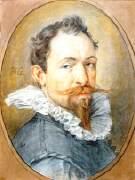 |
GOLTZIUS, Hendrick -- Click Here
|
|
Dutch Baroque Era Painter and Engraver, 1558-1617
Dutch draughtsman, printmaker, print publisher and painter. He was an important artist of the transitional period between the late 16th century and the early 17th, when the conception of art in the northern Netherlands was gradually changing. Goltzius was initially an exponent of Mannerism, with its strong idealization of subject and form. Together with the other two well-known Dutch Mannerists, Karel van Mander I and Cornelis Cornelisz. van Haarlem, he introduced the complex compositional schemes and exaggeratedly contorted figures of Bartholom?us Spranger to the northern Netherlands. These three artists are also supposed to have established an academy in Haarlem in the mid-1580s, but virtually nothing is known about this project. In 1590 Goltzius travelled to Italy, thereafter abandoning Spranger as a model and developing a late Renaissance style based on a broadly academic and classicizing approach. Later still, his art reflected the growing interest in naturalism that emerged in the northern Netherlands from c. 1600. |
|
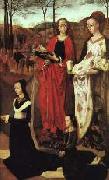 |
GOES, Hugo van der -- Click Here
|
|
Netherlandish Northern Renaissance Painter, ca.1440-1482
South Netherlandish painter. In 1467 he enrolled as master in the Ghent painters' guild, sponsored by Joos van Wassenhove, master painter in Ghent in 1464 after registering in Antwerp in 1460. In 1469 the two together acted as guarantors for the illuminator Sanders Bening when he became a master, and it was from Hugo that Joos borrowed money when he went to Rome. Sanders Bening was married to Kathelijn van der Goes, perhaps Hugo's sister. Hugo's status within the guild is further attested by the fact that he was guarantor for two other painters in 1471 and 1475, that he was one of the dean's jurors in 1468-9 and that he himself served as dean from towards the end of 1473-4 to at least 18 August 1475. |
|
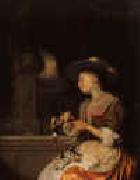 |
Godfried Schalcken -- Click Here
|
|
Dutch
1643-1706
Godfried Schalcken was born in 1643 at Dordrecht, and he studied under Samuel van Hoogstraten in Dordrecht before he moved to Leiden, into the studio of Gerard Dou (1613-1675), one of Rembrandt's most famous pupils. His earlier genre pictures very closely resemble Dou's work. He worked in Leiden until c. 1675, then returning to Dordrecht until 1691, after which he settled in The Hague, where he continued to paint until his death, near age 63, in 1706. He also visited England (1692-1697), but his uncouth manners and bad temper alienated him from the society there. In 1703 he was employed by Johann Wilhelm, Elector Palatine in D??sseldorf.
Mary Stanhope, Viscountess Fane, detail, 1702.Schalcken painted several portraits, of which the half-length of William III of England, now in the Rijksmuseum, Amsterdam, is a good example. Like Dou, Schalcken specialised in small scenes it by candlelight, a technique that found favour with the fijnschilders. Examples are in Buckingham Palace, the Louvre, Vienna and Dresden. His painting, Lady, Come into the Garden (Buckingham Palace), was singled out by his pupil Arnold Houbraken as representative of his oeuvre. Other good examples are Old Woman Scouring a Pan and Soldier Giving Money to a Woman (London, National Gallery), Ceres Seeking Proserpine and Old Man Writing (Louvre), Girl Blowing Out Taper (Munich), Girl Reading Letter (Dresden Gallery), The Boy Angling (Berlin); and Toilet by Candle (The Hague). The Buckingham Palace collection also possesses an interior by Schalcken. His history paintings are less-well known.
|
|
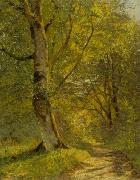 |
Godfred Christensen -- Click Here
|
|
(23 July.1845 - 15 November 1928) was a Danish landscaoe painter. He belonged to the transition between Romanticism and Realism. studied at the Royal Danish Academy of Fine Arts in Copenhagen from 1860 to 1867. |
|
|
|
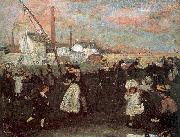 |
Glackens, William James -- Click Here
|
|
American Ashcan School Painter, 1870-1938
American painter and illustrator. He graduated in 1889 from Central High School, Philadelphia, where he had known Albert C. Barnes, who later became a noted collector of modern art. He became a reporter-illustrator for the Philadelphia Record in 1891 and later for the Philadelphia Press. In 1892 he began to attend evening classes in drawing at the Pennsylvania Academy of Fine Arts, studying under Thomas Anshutz. In the same year he became a friend and follower of Robert Henri, who persuaded him to take up oil painting in 1894. Henri's other students, some of whom were referred to as the Ashcan school, included George Luks |
|
 |
GIUSTO de Menabuoi -- Click Here
|
|
Italian painter, Florentine school (b. ca. 1320, Firenze, d. 1391,
Italian painter, Florentine school (b. ca. 1320, Firenze, d. 1391, was an Italian painter of the early Renaissance. He was born in Florence. In Lombardy he executed a fresco of the Last Judgement in the Abbey of Viboldone, Milan. He then moved to Padua where he completed frescos in the Church of the Eremitani, the Basilica of Saint Anthony of Padua and most notably, the Baptistery of the Duomo (1376). |
|
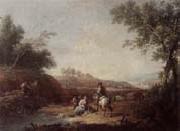 |
Giuseppe Zais -- Click Here
|
|
Italian Painter , Forno di Canale1709-1784 Treviso
was an Italian painter of landscapes (vedutisti) who painted mostly in Venice. He was born in Forno di Canale. He was influenced in his vedute by Marco Ricci and later Francesco Zuccarelli, who helped train him. He is best known for frescoes in Villa Pisani in Stra. While he had been a member of the Academy of Painters in Venice from 1774, he died in poverty at Treviso. |
|
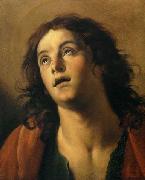 |
Giuseppe Vermiglio -- Click Here
|
|
Giuseppe Vermiglio (c.1585 - c.1635) was a Caravaggist painter from Northern Italy, active also in Rome.
Our knowledge of Vermiglioes life is sketchy. It is probable that he was born in Alessandria. He spent the first two decades of the seventeenth century in Rome where, while training and working as an artist, he adopted a bohemian lifestyle with a tendency to become involved in painterly brawling: in 1604 he supported his master Adriano di Monteleonees account of a dispute with two unknown artists which had led to Monteleone being wounded by his own wife; the following year Vermiglio was arrested and imprisoned after being discovered at the Monte di Brianza hostellry bearing an unlicensed sword; and in 1611 proceedings were brought against him for physically attacking the painter Silvio Oliviero. In 1618, still in Rome, he is recorded as a picture dealer.
Around 1620 he returned to northern Italy where he pursued his career as a painter in Piedmont (Novara and Alessandria) and in Lombardy (notably in Mantua and Milan).
His art was profoundly influenced by Caravaggio. Other painters to whom his work is thought, on the basis of stylistic references, to be indebted include the Bolognese Annibale Carracci and Guido Reni; it has been suggested that Vermiglio worked or studied in Bologna at some point. Luigi Lanzi acclaimed the painting of Daniel among the lions, in the library of the Passione in Milan, as his masterwork.
Judgments of quality of his work have ranged from Alfred Moires inconsequential craftsmane to Lanzies the best painter in oils of which the ancient state of Piedmont could boast, and one of the best Italian artists of his times. |
|
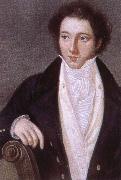 |
giuseppe verdi -- Click Here
|
|
Period: Romantic (1820-1869)
Country: Italy
Born: October 09, 1813 in Le Roncole, Italy
Died: January 27, 1901 in Milan, Italy
Genres: Chamber Music, Choral Music, Miscellaneous Music, Opera, Vocal Music
|
|
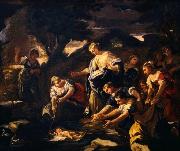 |
Giuseppe Simonelli -- Click Here
|
|
(Naples, c.1650 - 1710) was an Italian painter.
Born in Naples around 1650, Simonelli was one of the most important painters of the school of Luca Giordano. His early works were often retouched by Giordano to such a degree that some of them were confused with those of the master. He learned Giordanoes art so well that when the master left Naples for the Spanish court in 1692, he was assigned the task of completing the unfinished Neapolitan works for delivery to clients. Reliable details of his own production are available as from 1686, when he received the final payment for a painting of Holy Martyrs for the Jesuit college in Trapani. His most celebrated works are the series of 28 paintings for the Church of the Annunziata in Aversa, produced between 1702 and 1703 together with his brother Gennaro. He worked continuously right up to his death in 1710.
|
|
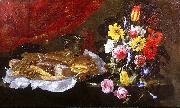 |
Giuseppe Recco -- Click Here
|
|
(1634 - 29 May 1695) was a still life Italian painter.
Born in Naples, he likely apprenticed with his family, including his father Giacomo Recco and uncle Giovan Battista Recco. His children both son Nicolo and daughter Elena were also painters. A large part of his output was painted in Spain, where his assemblies of victuals, both vegetable and animal, were popular. It is claimed he was influenced by the neapolitan Giovanni Battista Ruoppolo.
Recco died at Alicante, Spain. |
|
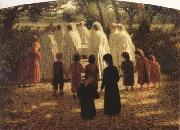 |
Giuseppe Pellizza da Volpedo -- Click Here
|
|
Italian, 1868-1907
was an Italian painter. He was born and died in Volpedo, in the Piedmont region of northern Italy. Pellizza, considered a neo-impressionist artist, was a divisionist painter - using small dots of paints according to specific color theory. His most famous work is Il Quarto Stato ("The Fourth estate"). This rich, expressive work has become a well-known symbol for progressive and socialist causes in Italy, and through out Europe. |
|
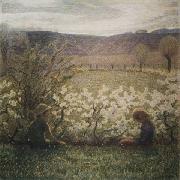 |
Giuseppe Pelizza -- Click Here
|
|
painted Prato fiorito in 1900 - 1903
|
|
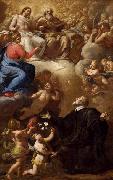 |
Giuseppe Passeri -- Click Here
|
|
Giuseppe Passeri
Giuseppe Passeri (12 March 1654 - 2 November 1714) was an Italian painter of the Baroque period, active in his native city of Rome.
Born the nephew of the painter Giovanni Battista Passeri, Giuseppe trained in the studio of Carlo Maratta. Among the paintings by Giuseppe is St. Peter baptizes the Centurion, transferred to mosaic; the original was moved to a church of the Conventuali in Urbino.
|
|
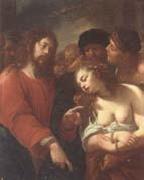 |
Giuseppe Nuvolone -- Click Here
|
|
Italian ,
b. 1619, Milano, d. 1703, Milano
was an Italian painter of the Baroque period, active mainly in Milan, Brescia, and Cremona. Born in San Gimignano. He was the brother of the painter Carlo Francesco Nuvolone and son and pupil of Panfilo. He painted St Dominic resurrecting the dead for the church of San Domenico in Cremona. |
|
 |
Giuseppe Maria Terreni -- Click Here
|
|
Italian , (1739-1811) |
|
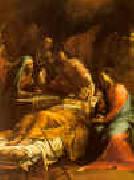 |
Giuseppe Maria Crespi -- Click Here
|
|
1665-1747
Italian
Giuseppe Maria Crespi Locations
1747). Painter, draughtsman and printmaker. His religious and mythological works are distinguished by a free brushstroke and a painterly manner. He also painted spirited genre scenes, which by their quality, content and quantity distinguish him as one of the first Italian painters of high standing to devote serious attention to the depiction of contemporary life. Such paintings as Woman Laundering (1700-05; St Petersburg, Hermitage) or Woman Washing Dishes (1720-25; Florence, Uffizi) offer straightforward glimpses of domestic chores in images that are startlingly novel for the period and look forward to the art of Jean-Simeon Chardin, Jean-Francois Millet and Honore Daumier |
|
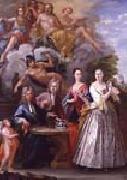 |
Giuseppe Grisoni -- Click Here
|
|
bapt. October 24, 1699 - 1769) was a Flemish/ Italian painter and sculptor, noted for his landscapes and historical tableaux.
Born in Mons, he studied in Florence under Tommaso Redi, abandoning his Flemish influences for the Italian tradition. In 1715 he travelled to London with John Talman and tried to establish himself as a portrait painter. One of his pupils was William Hoare (1707-1792)
|
|
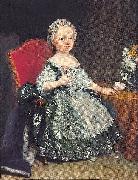 |
Giuseppe Dupra -- Click Here
|
|
(1703 -1784 ) - Painter |
|
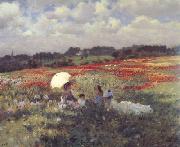 |
Giuseppe de nittis -- Click Here
|
|
Italian, 1846-1884
Italian painter, pastellist and printmaker. Throughout his career he was committed to a plein-air aesthetic and was particularly interested in rendering varying light effects, a concern that brought him into contact with the Impressionists. He was also acquainted with the members of the Macchiaioli, for whom his work was influential. In addition to oils, he experimented with printmaking and made innovative use of pastels. Practising a restrained, and therefore 'acceptable', form of Impressionism, |
|
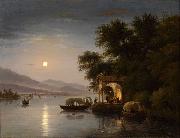 |
Giuseppe Canella -- Click Here
|
|
(28 July 1788 - 11 September 1847), also referred to as Giuseppe Canella the Elder, was an Italian painter.
Initially trained by his father Giovanni, an architect, fresco painter and set designer, Giuseppe Canella started out producing stage sets and decorating stately homes in Verona and Mantua. It may have been under the influence of Pietro Ronzoni, a landscape painter of international renown active in Verona, that he took up landscape. The first views were not produced until 1815, after a short stay in Venice. After making his debut at the Esposizione di Belle Arti di Brera of 1818, he made a long journey through Spain, the Netherlands and France for study purposes. The set of 13 landscapes shown at the Esposizione di Belle Arti di Brera in 1831 proved a great success with the public and critics alike, not least due to the fame achieved in Paris with works exhibited in the Salons, commissions from Louis Philippe of Orleans and the award of a gold medal in 1830. He returned to Milan in 1832 and devoted his energies to urban views characterised by an interest in the events of contemporary life and an atmospheric form of portrayal in evident competition with Giovanni Migliara. Landscape came to predominate as from 1835 with subjects drawn from the Lombard countryside and lakes. The focus on poor and humble aspects of life formed part of the artistes fundamental naturalism and coincided with a moralistic approach derived from the novelist Alessandro Manzoni. Crucial importance attaches in the artistes mature period to his trip to Rome and Naples in 1838-39.
|
|
 |
Giuseppe Cades -- Click Here
|
|
(December 8, 1750 - December 8, 1799) was an Italian sculptor, painter, and engraver.
Judgment of Solomon, Royal Academy of Arts, London.He was born in Rome. He studied under Mancini and Domenico Corvi, gaining a prize in 1765 with his picture of Tobias recovering his Sight. He visited Florence in 1766, and two years later executed an altar-piece for San Benedetto in Turin and in 1771 another for the Santi Apostoli. He also decorated the Palazzo Chigi with frescoes, landscapes, and scenes from Tasso. He has left two etchings, Christ blessing Little Children and The Death of Leonardo da Vinci. He died in Rome. |
|
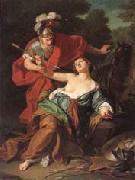 |
Giuseppe Bottani -- Click Here
|
|
Italian , Cremona 1717- Mantova 1784
was an Italian painter active in the Baroque period. He was born in Cremona. In Florence, he was a pupil of Vincenzo Meucci and il Puglieschi. He moved to Rome to work under Agostino Masucci, then he returned to Cremona after 1745. In 1769, he was named professor of painting and director of the Accademia di Belli Arti in Mantua. He was known for painting landscapes in the style of Gaspard Poussin, and figures in the style of Maratta. He painted a St. Paola taking leave of her Attendants as being in the church of SS. Cosmo e Damiano at Milan. |
|
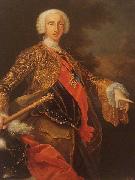 |
Giuseppe Bonito -- Click Here
|
|
Giuseppe Bonito (11 January 1707 - 9 May 1789) was a Neapolitan painter of the Rococo period. Giuseppe Bonito is known for genre depictions on canvas. Many of Gaspare Traversi's paintings had previously been attributed to Bonito.
Bonito was born at Castellammare di Stabia, and, like Traversi, was a student at the large studio of Francesco Solimena. Bonito represented urban scenes with folklore details and figures of commedia dell'arte. Between the 1736 and 1742 Bonito it worked for the family Borboni in the royal palace of Portici. He also painted portraits including one of Maria Amalia di Sassonia, wife of the Charles VII, king of Naples. |
|
 |
Giuseppe Benassai -- Click Here
|
|
painted La parola di Dio in 1885 |
|
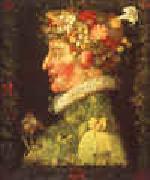 |
Giuseppe Arcimboldo -- Click Here
|
|
b.c. 1527, Milan,
d.1593, Milan Italian Giuseppe Arcimboldo Galleries
Arcimboldo was born in Milan in 1527, the son of Biagio, a painter who did work for the office of the Fabbrica in the Duomo.Arcimboldo was commissioned to do stained glass window designs beginning in 1549, including the Stories of St. Catherine of Alexandria vitrage at the Duomo. In 1556 he worked with Giuseppe Meda on frescoes for the Cathedral of Monza. In 1558, he drew the cartoon for a large tapestry of the Dormition of the Virgin Mary, which still hangs in the Como Cathedral today.
In 1562 he became court portraitist to Ferdinand I at the Habsburg court in Vienna, and later, to Maximilian II and his son Rudolf II at the court in Prague. He was also the court decorator and costume designer. King Augustus of Saxony, who visited Vienna in 1570 and 1573, saw Arcimboldo's work and commissioned a copy of his "The Four Seasons" which incorporates his own monarchic symbols.
Arcimboldo's conventional work, on traditional religious subjects, has fallen into oblivion, but his portraits of human heads made up of vegetables, fruit and tree roots, were greatly admired by his contemporaries and remain a source of fascination today. Art critics debate whether these paintings were whimsical or the product of a deranged mind.. A majority of scholars hold to the view, however, that given the Renaissance fascination with riddles, puzzles, and the bizarre (see, for example, the grotesque heads of Leonardo da Vinci, a fellow Milanese), Arcimboldo, far from being mentally imbalanced, catered to the taste of his times.
Arcimboldo died in Milan, to which he retired after leaving the Habsburg service. It was during this last phase of his career that he produced the composite portrait of Rudolph II (see above), as well as his self-portrait as the Four Seasons. His Italian contemporaries honored him with poetry and manuscripts celebrating his illustrious career. His hidden-face still-lives are a possible influence on his younger Lombard contemporary Caravaggio, whose painting of fruit in the Brera museum in Milan ranks as one of the earliest independent still-lives.
When the Swedish army invaded Prague in 1648, during the Thirty Years' War, many of Arcimboldo's paintings were taken from Rudolf II's collection.
His works can be found in Vienna's Kunsthistorisches Museum and the Habsburg Schloss Ambras in Innsbruck, the Louvre in Paris, as well as numerous museums in Sweden. In Italy, his work is in Cremona, Brescia, and the Uffizi Gallery in Florence. The Wadsworth Atheneum in Hartford, Connecticut, the Denver Art Museum in Denver, Colorado, the Menil Foundation in Houston, Texas, and the Candie Museum in Guernsey also own paintings by Archimboldo. |
|
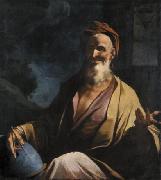 |
Giuseppe Antonio Petrini -- Click Here
|
|
(October 23, 1677- c. 1755-9) was a painter of the late-Baroque, active mainly in Lugano, present-day Switzerland.
St. Andrew
City Museum of Rimini, ItalyWhile born in Carona in Canton Ticino and died in Lugano, both in Switzerland, Petrini belongs to the Northern Italian or Lombard heritage of baroque painting. He possibly apprenticed with Bartolomeo Guidobono after 1700. While some works can be found in Como and Bergamo, most are located in Lugano and the surrounding area. He is also listed between 1711 and 1753 as fabbriciere of the church of Madonna deOnegro in Carona. He often painted "portraits" of historical figures including saints, philosophers, and scientists for patrons. One of his more prominent examples is his depiction of an auster St. Peter emerging from the shadows to pinpoint some lines in the gospel. He painted another St. Peter for the parish church of Dubino. Pietro Ligari classified him among the speculative painters, since these portraits, by nature, were imagined.
|
|
 |
Giuseppe Abbati -- Click Here
|
|
Italian, 1836-1868
Abbati was born in Naples and received early training in painting from his brother Vincenzo. He participated in Garibaldi 1860 campaign, suffering the loss of his right eye at the Battle of Capua. Afterwards he moved to Florence where, at the Caffe Michelangiolo, he met Giovanni Fattori, Silvestro Lega, and the rest of the artists who would soon be dubbed the Macchiaioli.
While his early paintings were interiors, he quickly became attracted to the practice of painting landscapes en plein air. His activity as a painter was interrupted during 1866 when he enlisted again in the army for the Third Independence War, during which he was captured by the Austrians and held in Croatia.
Returning to civilian life at the end of the year, he moved to Castelnuovo della Misericordia and spent the final year of his life painting in the countryside. Abbati died at the age of thirty-two in Florence after his own dog bit him, infecting him with rabies.
Giuseppe Abbati, The Tower of the Palazzo del Podesta, 1865, oil on wood, 39 x 32 cm.His paintings are characterized by a bold treatment of light effects. He often painted a luminous landscape scene as seen through the doorway of a darkened interior, as in the View from the Wine Cellar of Diego Martelli (1866). Some of his late landscapes are in the greatly elongated horizontal format often favored by the Macchiaioli. |
|
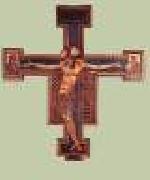 |
GIUNTA PISANO -- Click Here
|
|
Italian painter, Pisan school (active c. 1229-c. 1254 in Pisa).
|
|
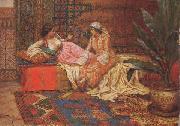 |
Giulio Rosati -- Click Here
|
|
Italian Painter, 1858-1917 |
|
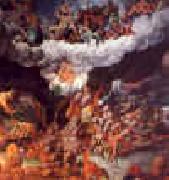 |
Giulio Romano -- Click Here
|
|
Italian
1492-1546
Giulio Romano was born in Rome. In his native city, as a young assistant in Raphael's studio, he worked on the frescos in the Vatican loggias to designs by Raphael and in Raphael's Stanze in the Vatican painted a group of figures in the Fire in the Borgo (L'incendio di Borgo) fresco. He also collaborated on the decoration of the ceiling of the Villa Farnesina. After the death of Raphael in 1520, he helped complete the Vatican frescoes of the life of Constantine as well as Raphael's Coronation of the Virgin and the Transfiguration in the Vatican. In Rome, Giulio decorated the Villa Madama for Cardinal Giuliano de' Medici, afterwards Clement VII. The crowded Giulio Romano frescoes lack the stately and serene simplicity of his master.
In the Palazzo Te, MantuaAfter the Sack of Rome in 1527 and the death of Leo X, artistic patronage in Rome slackened. Vasari tells how Baldassare Castiglione was delegated by Federico Gonzaga to procure Giulio to execute paintings and architectural and engineering projects for the duchy of Mantua. His masterpiece of architecture and fresco painting in that city is the suburban Palazzo Te, with its famous illusionistic frescos (c. 1525?C1535). He also helped rebuild the ducal palace in Mantua, reconstructed the cathedral, and designed the nearby Church of San Benedetto. Sections of Mantua that had been flood-prone were refurbished under Giulio's direction, and the duke's patronage and friendship never faltered: Giulio's annual income amounted to more than 1000 ducats. His studio became a popular school of art. |
|
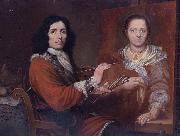 |
Giulio Quaglio -- Click Here
|
|
(1610-1658 or after) was an Italian painter of frescoes.
He was a follower of Tintoretto. He is known to have worked in Vienna, Salzburg, and Ljubljana. His son, Giulio the younger, was born in Como and established himself in the Friuli about the end of the 17th century. He is best known for frescoes at the chapel of the Monte di Piete, at Udine. He died in 1720. They are both part of a large family of artists and architects from the town of Laino, between Lake Garda and Lake Como, and which included Giuseppe Quaglio and his sons Lorenzo the younger, Simon, and Domenico; Lorenzo Quaglio the elder; and Giovanni Maria Quaglio and his son.
|
|
 |
Giulio Cesare Procaccini -- Click Here
|
|
1574-1625 Italian Giulio Cesare Procaccini Gallery
Giulio Cesare Procaccini (1574-1625) was an Italian painter and sculptor of the early Baroque era in Milan.
Born in Bologna he was son of the Mannerist painter Ercole Procaccini the Elder and brother of Camillo Procaccini and Carlo Antonio Procaccini. The family moved to Milan around 1585 with the help of the rich art collector Pirro Visconti.
He began as a sculptor in the Cathedral and in the Milanese church of Santa Maria presso San Celso. In 1610 he painted six of the Quadroni, large canvases celebrating Saint Charles Borromeo .
Among his many altarpieces are the Circumcision now in Galleria Estense, Modena (c.1616) and the Last Supper (1616) for Convent associated with the Basilica della Santissima Annunziata del Vastato in Genoa. He also painted the Scourging of Christ.
He worked with Giovanni Battista Crespi (il Cerano) and Pier Francesco Mazzucchelli (il Morazzone) following the directions of Cardinal Federico Borromeo, patron of the arts and cousin of Charles Borromeo. He also painted small religious canvases for rich families, in Milan and in Genoa, where he saw the works of Rubens.
His style shows the influence of Bolognese Mannerism and Venetian colorism and marks the beginning of the Baroque. |
|
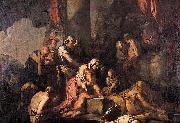 |
Giulio Carpioni -- Click Here
|
|
(1613 - 29 January 1678) was an Italian painter and etcher of the early Baroque era.
Born probably in Venice, Carpioni studied under Alessandro Varotari (il Padovanino) and was also influenced by the work of Simone Cantarini, Carlo Saraceni and Jean Leclerc. He came into contact with Lombard art after a brief visit to Bergamo in 1631. In 1638 he settled in Vicenza and executed most of his work there.
He painted history and bacchanals, and also sacred subjects of a small size, many of which are to be seen in the churches in the Venetian states. Paintings by him may be seen in the Galleries of Augsburg, Dresden, Vienna, Modena, and Florence. He was also an etcher; his best plates being St. Anthony of Padua, Christ on the Mount of Olives, The Virgin reading, and The Virgin with Rosary. He died at Verona. Carlo Carpioni, his son, was also a painter.
Among his important works are the Apotheosis of the Dolfin family (1647) and the Allegory of the Grimani Family (1651), and altarpiece of Sant'Antonio da Padova, a Virgin and two saints, and a Triumph of Silenus in the Gallerie dell Accademia of Venice. He painted a series of canvases for the Oratory of San Nicola da Tolentino in Vicenza.
|
|
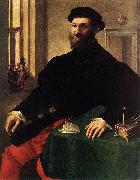 |
Giulio Campi -- Click Here
|
|
(1500 - 5 March 1572) was an Italian painter and architect. His brothers Vincenzo Campi and Antonio Campi were also renowned painters.
The eldest of a family prominent painters, Campi was born at Cremona. His father Galeazzo (1475-1536) taught him the first lessons in art.
In 1522, in Mantua, he studied painting, architecture, and modelling under Giulio Romano. He visited Rome, became an ardent student of the antique, and like Bernardino e distantly related to him e he combined a Lombard and Roman traditions. He collaborated on some works with Camillo Boccaccino, the son of Boccaccio Boccaccino, with whom Campi may also have received training.
Campi is called the "Ludovico Carracci of Cremona" although he preceded the founder of the Eclectics. When but twenty-seven Giulio executed for the church of Sant' Abbondio his masterpiece, a Virgin and Child with Sts. Celsus and Nazarus, a decoration masterly in the freedom of its drawing and in the splendour of its colour. His numerous paintings are grandly and reverently conceived, freely drawn, vigorously coloured, lofty in style, and broadly handled. He was animated in all his work by a deep piety. Numerous of his fresco works are housed in churches of Cremona, Mantua, Milan and in the church of Saint Margaret's, in his native town. Among his chief works are the Descent from the Cross (S. Sigismondo) at Cremona, and the frescoes in the dome of S. Girolamo at Mantua. An altar-piece in S. Sigismondo and his Labours of Hercules were engraved by the celebrated Ghiso, il Mantovano.
He died in Cremona in 1572.
|
|
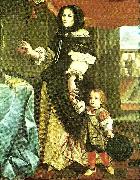 |
gittadini -- Click Here
|
|
In Venezia, 1585, in duodecimo. Cittadini was born in Rome, and died at Florence, 1622, |
|
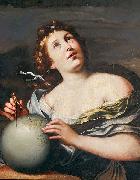 |
Girolamo Troppa -- Click Here
|
|
Girolamo Troppa (1637-1710) was an Italian painter of the Baroque. He was active in Rome. He was a follower of Carlo Maratti. He painted for the church of San Giacomo delle Penitenti, in competition with the son of Giovan Francesco Romanelli. He died in 1710. |
|
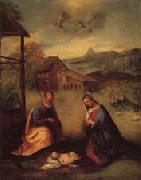 |
Girolamo Romanino -- Click Here
|
|
Italian High Renaissance Painter, 1484-1562 |
|
|
|
|
| | |
|
|
|
|